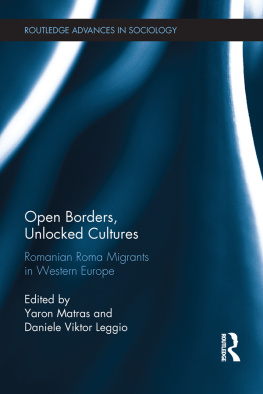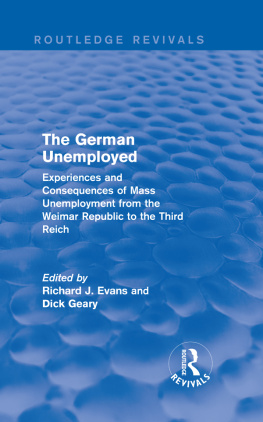Sinti and Roma in Germany (18711933)
This book concerns the persecution of the Sinti and Roma in Germany during the Second Empire (18711918) and Weimar Republic (19191933). It traces the ways in which discriminatory treatment towards Gypsies developed in a state ostensibly committed to individual liberty and equal treatment under the law, and how government policies in this period furthered their economic marginalisation and social exclusion.
It will provide much-needed detail on a crucial period, one which is ordinarily addressed only fleetingly, and by way of introduction, to studies of how the Sinti and Roma communities were treated by National Socialists.
Simon Constantine is a Senior Lecturer in History at the University of Wolverhampton, UK.
Routledge Studies in Modern European History
75 Immigrants and Foreigners in Central and Eastern Europe during the Twentieth Century
Edited by Wodzimierz Borodziej and Joachim von Puttkamer
76 Europe between Migrations, Decolonization and Integration (19451992)
Edited by Giuliana Laschi, Valeria Deplano, Alessandro Pes
77 Steamship Nationalism
Ocean Liners and National Identity in Imperial Germany and the Atlantic World
Mark Russell
78 Transatlantic Anarchism during the Spanish Civil War and Revolution, 19361939
Morris Brodie
79 Emotions and Everyday Nationalism in Modern European History
Edited by Andreas Stynen, Maarten Van Ginderachter and Xos M. Nez Seixas
80 Black Abolitionists in Ireland
Christine Kinealy
81 Sinti and Roma in Germany (18711933)
Gypsy Policy in the Second Empire and Weimar Republic
Simon Constantine
82 German Neo-Pietism, the Nation and the Jews
Religious Awakening and National Identities Formation, 18151861
Doron Avraham
For more information about this series, please visit: https://www.routledge.com/history/series/SE0246
Sinti and Roma in Germany (18711933)
Gypsy Policy in the Second Empire and Weimar Republic
Simon Constantine
First published 2020
by Routledge
2 Park Square, Milton Park, Abingdon, Oxon OX14 4RN
and by Routledge
52 Vanderbilt Avenue, New York, NY 10017
Routledge is an imprint of the Taylor & Francis Group, an informa business
2020 Simon Constantine
The right of Simon Constantine to be identified as author of this work has been asserted by him in accordance with sections 77 and 78 of the Copyright, Designs and Patents Act 1988.
All rights reserved. No part of this book may be reprinted or reproduced or utilised in any form or by any electronic, mechanical, or other means, now known or hereafter invented, including photocopying and recording, or in any information storage or retrieval system, without permission in writing from the publishers.
Trademark notice: Product or corporate names may be trademarks or registered trademarks, and are used only for identification and explanation without intent to infringe.
British Library Cataloguing-in-Publication Data
A catalogue record for this book is available from the British Library
Library of Congress Cataloging-in-Publication Data
A catalog record has been requested for this book
ISBN: 978-0-815-39461-7 (hbk)
ISBN: 978-1-351-18551-6 (ebk)
Typeset in Times New Roman
by codeMantra
I would like to thank the staff of the different archives and libraries I have visited for their help and for the programmes of digitization that they have initiated. I would also like to express my gratitude, in particular, to Doris Kock of Mnsters Hochschule der Polizei for her interest and expertise, and to Wolverhampton Universitys Centre for Historical Studies for funding the archival research that was necessary for this book to come to fruition. Above all I thank my parents, for their encouragement and insight, and especially Konni, Anna and Clara, for being so close.
Gypsies, Sinti, Roma
This study concerns the people whom most Germans in this period called Zigeuner. In English, Gypsies, used pejoratively, conveys much the same meaning. Where I use Zigeuner or Gypsies in the following pages, it reflects this majority, and usually pejorative usage, or, more specifically, refers to the Zigeuner of the policy documents the label assigned to the group targeted by police and officials.
In most cases the Gypsies in question were the Romani-speaking minority who called themselves Sinti including a German Sinti population and some Sinti from Moravia and Bohemia with their own distinct identity who also crossed into the Reich. Other culturally affiliate and Romani-speaking groups from Southern and Eastern Europe including the Lovari, Kelderari and Ungari, and who shared a broader identity as Rom, were also present in Germany in smaller numbers. Throughout the book I use the collective term Sinti and Roma, which was adopted in the 1980s by campaigners for the civil rights of these different groups. Although slightly anachronistic, it reasserts the cultural identity hidden by the label Zigeuner, and is also convenient, because it is often not possible to tell from the historical record which particular Sinti or Roma group is being discussed. (The surnames adopted by the different families often indicate this but are also not entirely reliable.)
Importantly,
Throughout the period it was the itinerant lifestyle of Gypsies, widely regarded as anti-social, which was the chief preoccupation of the authorities. For this reason, and out of a concern that the police were using too narrow a definition, policymakers would also go on to clarify that groups who were travelling around like Gypsies, should also be targeted. For example, the decree issued in 1906 by the Interior Minister of Saxe-Altenburg ordered police to tackle not only bands of Gypsies, but also individuals whose lifestyle, appearance and occupation mean they are to be regarded as Gypsies. It mentioned, specifically, tinkers and potmenders, tin and wire merchants, horse dealers, jugglers and conjurers.
For their part, the gendarmes and chasseurs (
Gypsy policy
This book explores only one phase in a much longer history of repression. From the point of their arrival in German lands in the early fifteenth century the Sinti and Roma were denounced variously as heathens and spies, feared as carriers of disease and resented as beggars and thieves. Local craftsmen and traders saw them as unwelcome competition and lawmakers ordered their expulsion, conferring upon them the status of outlaws. In the hundred years which followed the Thirty Years War (16181648), a succession of edicts were issued sanctioning the mutilation and killing of Gypsies, or their capture and enslavement as forced labour. Frederick the Greats edict of 1774 also applying to beggar Jews and other unwanted itinerants stipulated that those born in Prussia who could prove that they were living by honest means should be left in peace, but that others caught on Prussian territory be committed to penitentiaries to perform forced labour, and that children below the age of 12 should be removed to the care of orphanages. By the beginning of the nineteenth century sedentarisation and assimilation, most notably an attempt to remould and civilise families at Friedrichslohra, had also emerged as policies alongside expulsion and incarceration.








